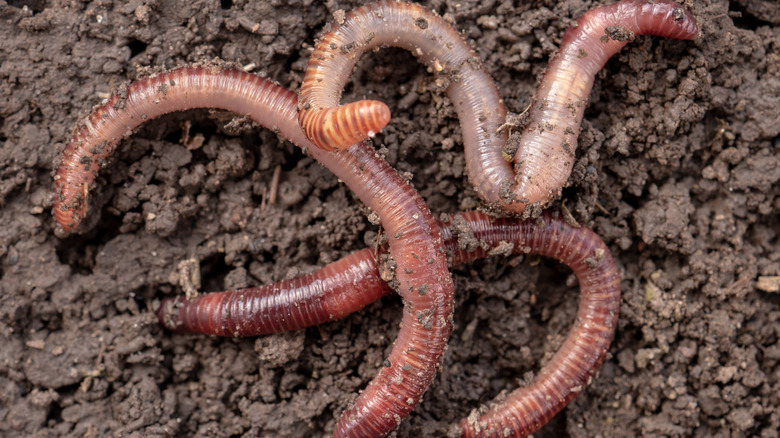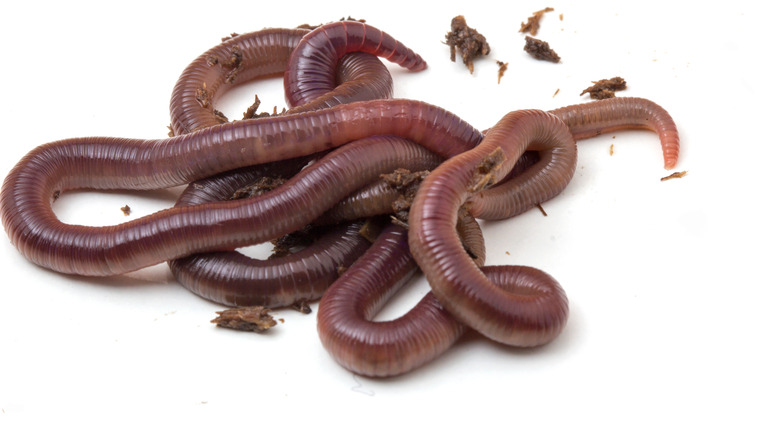How To Attract Worms To Your Garden And Why You Want To
People tend to think of worms as repugnant — slimy, creepy, or even disgusting. Who hasn't seen one writhing on the sidewalk after a rainstorm? Or been taunted by an elementary school classmate waving a worm in your face? Touch one? No, thank you. Yet, this unfairly maligned creature plays a vital role in enhancing soil quality, natural recycling, erosion prevention, and aiding plant growth, according to Soil Association. Worms are also a key component of the food chain and no less of an authority than Charles Darwin sang their praises.
Earthworms have inhabited the Earth for at least 300 million years. There are more than 7,000 species in 23 families, according to the USDA. They are hermaphroditic invertebrates and herbivores, and they can range from an inch in length to a colossal 2 yards. The common earthworm (lumbricus terrestris) is native to Europe and was introduced by settlers to North America, where it now thrives. Most early native earthworm species were wiped out during the Ice Age.
They are not harmful to humans or pets. Nicknamed "nature's plows," earthworms are essential for a vigorous and vibrant garden, per Almanac. In fact, where there are earthworms, there is healthy soil. Rather than being the object of scorn, the lowly worm should be appreciated for its gifts to nature. And there are many strategies for attracting them and benefitting your garden or yard.
Why attract worms?
Earthworms are not called "nature's plows" for nothing. The burrowing movements of earthworms and their digestive processes are fundamental in improving soil quality. As they move, worms ingest soil and draw nutrients from decaying leaves, roots, fungi, and bacteria, as National Geographic explains. This matter is broken down in their intestines and excreted in the form of element-rich "castings." The castings, having been treated by worms' microorganisms, contain more nutrients than the original soil. They serve as a potent natural fertilizer. In this process, worms recycle the decomposed organic material they feed on into a humus-laden soil capable of boosting crop growth by almost 25% (per Together Time Family).
Worms also mix soil from different strata by way of their wanderings. This helps to mingle organic matter throughout their territories. Earthworms live in vertical or horizontal burrows, which promote drainage, facilitate root growth, and make soil more porous, according to USDA. Soil that is porous combats erosion and is more resistant to flooding. Plants with deeper roots are better able to absorb moisture and nutrients. The burrowing action of worms helps to aerate the soil and allows water to move more easily through it as well. At death, earthworms decompose rapidly and infuse nitrogen into the soil (per NSW).
How to attract worms
Worms are more likely to be attracted to your garden if you plow, till, or hoe it less. Piling leaf debris and other organic material on the garden surface will draw them to it. Allowing this to rot will also be a magnet. Harsh chemicals will deter worms. However, you will not have to rely on them in your garden: Earthworm castings are natural insect repellents and can resist some plant diseases, according to Together Time Family. Worms favor soil that is moist and cool, and an organic mulch will be effective in attracting them. Worms require water, and a loamy soil with neutral pH would be their first choice.
While some websites say to use cornmeal to attract worms, Worm Farm Business warns that this type of feeding can make your soil more acidic. The real key is not to overdo the feeding, so you don't kill your worms by feeding them minimal amounts at a time and watching how much they eat each day.
Attracting worms can have the added benefit of drawing birds to your property. Robins and worms are a natural pairing. Other worm eaters include woodpeckers, starlings, bluebirds, orioles, nuthatches, and some owls (In To Yard). Earthworms are your ally too, but sadly, their numbers are dwindling due to modern agricultural methods.


